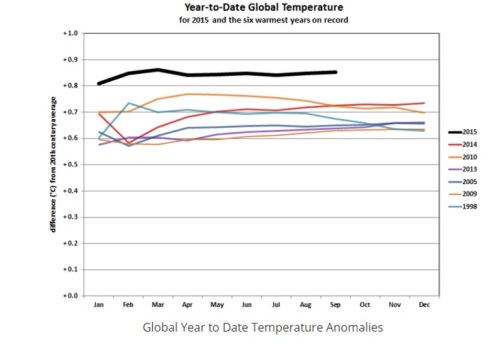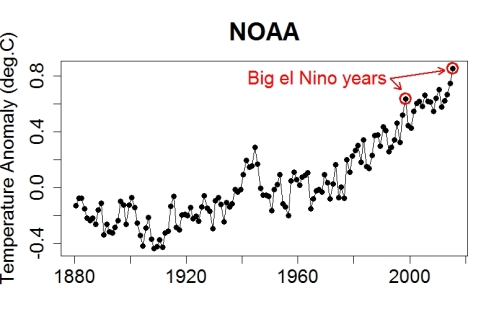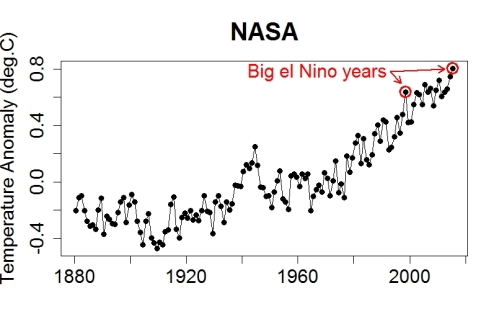Desperate to hold on to the “pause” that never happened in global warming, David Whitehose has penned a piece for the Global Warming Policy Foundation (GWPF). What he really shows is that it’s a very bad year indeed for the GWPF.
He objects to this graph:
It shows global temperature year-to-date (using data from NOAA) for 2015 (that’s the one way at the top) compared to the same for the next six hottest years on record. David Whitehouse doesn’t like that — because it shows, in graphic terms, how much hotter this year has been than its predecessor, and just how likely it is that 2015 will be the new #1 hottest. A fact which even David Whitehouse admits.
His “argument” is that the “pause” (the one that never happened) hasn’t ended, mainly because not every month this year so far has been the hottest on record. To make that argument, he switches from NOAA data to NASA data. He also points out that only 5 of 9 months (so far this year) have been hotter than the same month last year (he doesn’t bother with “by how much”). He also blames the record-breaking year-to-date (in NOAA and NASA data, and HadCRUT4 to boot) on the current el Nino. It’s true that el Nino years tend to be hotter … which is why 1998 was so hot, and why deniers usually start their “no warming since” graphs with 1998. Finally, he emphasizes that there’s uncertainty in global temperature, of about 0.1 deg.C.
Which is funny, because when deniers were in “full pause mode” (the pause that never happened) they didn’t talk about uncertainty. And yes, they started their “pause” meme with 1998 and because of 1998 being such a hot year.
What’s also funny is the “not the hottest month every month” argument. Suppose you played a baseball game — nine innings — and in the first inning you only scored th 2nd-most runs in league first-inning history, in the second inning you only scored the 2nd-most runs in league second-inning history, etc. etc. After nine innings, you’ve scored the most total runs in one game in league history. But that’s worthless; I guess, according to David Whitehouse, your offensive scoring is in a “pause” (you know, the one that never happened).
What’s not funny is David Whitehouse simply denying the truth:
Despite this extensive research taking place Peter Hannam continues in his article with a very out-of-date comment. “For years, climate change sceptics relied on a spike in global temperatures that occurred during the monster 1997-98 El Nino to say the world had stopped warming because later years struggled to set a higher mark even as greenhouse gas emissions continued to rise.” This myth has been addressed so many times. The year 1998 and its strong El Nino has nothing to do with the pause. Neither “climate sceptics” nor climate scientists would fall for such an obvious aspect of the data, but it seems journalists still do!
Au contraire. Fake skeptics (a.k.a. deniers, a.k.a. climate anti-vaxxers) exploit the 1998 el Nino, have for years. And climate “skeptics” fall for it all the time.
As for the whole el Nino thing, it looks like we’ve got a strong one going on right now. The last time we had such a big one was 1998. Were those years so hot only because of the el Nino? Let’s compare the two directly (2015 isn’t complete, so I’ve plotted year-to-date):
Both of the big el Nino years were hotter than nearby years. But they weren’t just hot because of el Nino, they were hot because of global warming. That’s why this year is so much hotter than the 1998 monster el Nino. That’s why 2005, 2007, 2010, 2014 all broke the 1998 record in spite of 1998 being a monster el Nino. Because there is no “pause.” It never happened.
You can see the same thing with NASA data (again, 2015 is year-to-date):
He closes with this utterly nonsensical non-sequitur:
What the data is showing us is that over the past 15 years or so there has been little underlying change with El Ninos elevating the temperature a little and La Ninas reducing them. Is what is happening to global annual average surface temperatures all that surprising?
Surprising? Of course not. Because the globe is warming. Because of us. As for the “pause” that David Whitehouse and the GWPF so desperately cling to — it never happened.






2015 is equivalent to 1997, not 1998. A noticeable effect of the current El Nino on global average temperatures has really only just begun.
I agree. 2016 could make it a three-pete.
Peat. 1998 ended in a La Nina.
2015 is not quite the equivalent of 1997–every ENSO is different. One of the unusual features of the current ENSO is that it did not start in the fall of 2014 but instead started in Spring 2015. Such a pattern shifts much of the temperature anomaly into 2015, since the ENSO is predicted to dissipate near the beginning of next summer. So, I expect that 2016 will probably near the same temperature as 2015.
Mitch,
ENSO is arround 4m lag to Global Temperature, if we only conclude effects of El-Nino, El-Nino will influence 2016 more then this year. If there is not a strong vulcanic erruption or Alien Attack or asteroid impact, its much as likely 2016 will become warmer then 2015.
You will see it the next several months, El-Nino-effects are now to gain in the Data-Sets
Most el ninos are certainly hotter in the second year, which would be 2016. However 02/03 is an exception with 03 just slightly cooler than 02, so perhaps 2016 could end up being only the 2nd hottest year on record (and 2015 no 1). It is interesting to note that satellite measures which are more sensitive to ENSO have not yet increased anywhere near as much as could be expected in an El nino. This to me is a hint that el nino warming is still in the pipeline. To be sure though you’d need to understand why the surface temperatures have increased significantly in the last year or so, whereas the satellite measurements have not.
@ Paul S
Y, correct you are. Under this circumstances, its very likely that 2016 becomes 0.1-0.2K warmer then 2015. The current warming (in my opinion) of 2014/2015 is linked to increased upper-Heatcontent of the Oceans, the exchange between upper and deep ocean beginns to slow down, beside the El-Nino ,this kind of warming will not dissapear with the next La-Nina-Event.
It’s certainly possible that 2016 will be warmer than 2015, and it fits the normal pattern.
This El Nino, however, does not. We had an aborted El Nino in 2014, and as a result, the sea surface temperatures were already unusually warm in early 2015. So it seems plausible that the warm pool will be exhausted faster, and that 2016 will not be as warm as we expect, or that the La Nina that follows will be stronger than usual, too.
My only point is: let’s not count our chickens before they hatch. We’re in uncharted territory here.
What scares me is that for the next few years we will see everything possible done to muddy the waters and then after that the skeptics will start with a new round of no warming since blah blah. I’m just so sick of it.
Should rising global temperatures become too dramatic, Whitehouse and the other Gentlemen Who Prefer Fantasy will find themselves a little embarrassed. This is because both the “Foundation” (a UK charity that spreads lies about AGW at the UK-taxpayer’s expense) and the “Forum” (where the egregious lies and nonsense that are too embarrassing for a so called “educational charity” have to be placed – including this present serving from Whitehouse) – both these denialist entities have a website masthead featuring a much-stretched graph of HadCRUT4 global temperatures 2000-to-date. So if temperatures were to rise too dramatically, every page of lies regurgitated by these numpties will be headed by a graphic showing the content for what it is.
And given the GWPF penchant for HadCRUT4, strange Whitehouse doesn’t mention how that record stands within his unique blend of puerile analysis. To illuminate this dark corner, HadCRUT4 shows only one of the eight 2015 months-to-date to be cooler than 2014. And the monthly standings of those eight 2015 months – 2nd, 3rd, 2nd, 3rd, 1st, 1st, 1st, 1st. I reckons that makes 2015 “proper scotchio!!!!”
My irony meter just supernova’d!
Yes Bob, and it continues:
The year 1998 and its strong El Nino has nothing to do with the pause. Neither “climate sceptics” nor climate scientists would fall for such an obvious aspect of the data, but it seems journalists still do!
“2015: A Very Bad Year for the Global Warming Policy Foundation”
Another mishap. Remember the “Top scientists start to examine fiddled global warming figures”? In the Telegraph, no less. But
it collapsed, within weeks of the deadline for submissions.
A rather fascinating story. Please update us if anything should surface.
And now it’s looking like a bad year for Manzanillo, Mexico:
http://www.cbc.ca/news/world/hurricane-patricia-pacific-coast-1.3285229
Strongest on record apparently–though this claim seems to be plagued by definitional issues–hitting 325 km/h and 880 millibars before weakening slightly. Tropical depression to Cat 5 hurricane in about 36 hours over extremely warm surface waters…
It’s about to hit the coast near Porto Vallajarta, with 160,000 people in the crosshairs. I’m wishing them the best possible outcome in such a situation, but it doesn’t look promising at this point.
http://www.gdacs.org/Cyclones/report.aspx?episodeid=14&eventid=1000231&eventtype=TC
According to early reports, Patricia missed Manzanillo, striking a relatively unpopulated part of the coast. Now it’s a Cat 1 over the mountains, basically a rain event. Lucky for the coast!
Taming,reading your work for a long time , learn and enjoy every post.I’m a layman , farmer living in South Australia…
Seems to me a graphing of el Nino event global temps would clearly show a trend, and help illustrate that it is not these events that are driving global warming, but that global warming is causing el
Nino years to be trending hotter.
[Response: It’s been done (by others). Anybody know the link? SkS?]
Hey Brian, take your pic.
[Animated] – http://www.skepticalscience.com/graphics.php?g=67
[Still image] – http://www.skepticalscience.com/john-nielsen-gammon-commentson-on-continued-global-warming.html
[Longer term] – http://www.giss.nasa.gov/research/news/20140121/
This graph (backup) shows global mean surface temperature (GMST) during just el Ninos in recent decades (excluding Pinatubo).
As Tamino suggests, Skeptical Science have indeed published that graph.
http://www.skepticalscience.com/global-warming-made-2014-record-hot-year-animated-graphics.html
Sounds similar to this post by John Nielsen-Gammon. It’s a few years old, but still good.
I tire of correcting this kind of statement… can you stop them?
“A single record-breaking event, even within in a record El Niño year, cannot be linked to climate change.”
http://www.npr.org/sections/thetwo-way/2015/10/23/451208663/why-hurricane-patricia-cant-be-blamed-on-climate-change
I posted this on NPRs site:
http://www.npr.org/sections/thetwo-way/2015/10/23/451208663/why-hurricane-patricia-cant-be-blamed-on-climate-change
NPR should be ashamed for promoting climate confusion. Climate is a collection of single weather events… so ANY ONE event is one data point of that climate. Just as no single event is part of climate until many, many events define climate. And you should know better, that climate does not CAUSE weather.
Instead one could say that increased heating of the atmosphere caused by CO2 emissions from carbon combustion acts to destabilize the atmosphere so that extreme weather events are more possible.
Really, NPR, that’s why you are losing listeners, better science can be found elsewhere.
Here is the John Nielsen-Gammon graph:
http://www.skepticalscience.com/john-nielsen-gammon-commentson-on-continued-global-warming.html
Tamino and Brian, this article by US climatologist John Neilsen-Gammon might be what you are after. It features a chart of surface temperatures from 1951 to 2011, with individual years marked as strong La Nina, neutral and strong El Nino. He then draws trendlines to show that the La Nina years are all getting warmer, the neutral years are all getting warmer, and the El Nino years are all getting warmer, all at about the same rate.
The great benefit of separating out the three ENSO phases in this way is that it both reveals the underlying greenhouse forcing, and the short term strength of the ENSO cycle -for example, 1999 (a La Nina year) is clearly much cooler than 1998, but is also clearly warmer than all previous La Nina years.
This separation of La Nina, neutral and El Nino trends is one of my favourite climate graphs.
http://blog.chron.com/climateabyss/2012/04/about-the-lack-of-warming/
Of course he’s quite right to plead not guilty to the cherry pick of starting in 1998. The denialist standard is “no statistically significant warming since xxxx”, where xxxx is the furthest date in the past for which that claim is true. When I remember them starting this meme, the chosen start date was 1994 (I think).
Skeptical Science has a graphic which shows the global mean surface temperature anomaly trends for El Nino, La Nina, and neutral years separately: http://www.skepticalscience.com/graphics.php?g=67
Following from your baseball example Tamino, since the GWPF is English, I thought I’d add a cricket version.
In cricket, the team’s total innings is the sum of the batters’ individual innings. 2 players bat at a time, so the innings consists of 10 ‘partnerships’. Following from Whitehouse’s own ranking of each month of 2015 so far, and treating each month as equivalent to one of the cricket partnerships in order, I’ve worked out what the final result would be if the players in a game of cricket scored as each month so far ranks in the record books.
According to ESPN Cricket’s Almanac of records:
The 2nd highest 1st wicket partnership: 413 runs
The 2nd highest 2nd wicket partnership: 451 runs
The 3rd highest 3rd wicket partnership: 451 runs
The 4th highest 4th wicket partnership: 388 runs
The 2nd highest 5th wicket partnership: 385 runs
The highest 6th wicket partnership: 365 runs
The 2nd highest 7th wicket partnership: 308 runs
The 2nd highest 8th wicket partnership: 313 runs
The 2nd highest 9th wicket partnership: 190 runs
There would normally be one more partnership to go, but even with one innings short, the total comes to 3,264 runs.
The highest team total ever recorded in the history of cricket is 952 runs!
Brian F: like this? http://www.skepticalscience.com/john-nielsen-gammon-commentson-on-continued-global-warming.html
It shows trend lines for El Nino, La Nina and neutral years
Maybe it’s stating the obvious, but I can’t help thinking that if 1998 had been close to the 97 and 96, the whole pause/hiatus/slowdown meme wouldn’t have happened – for those just eyeballing the chart the 2000s would have looked quite different without that one spike before.
Either way, next year the GWPF might have to rethink their website banner which features a global average temperature chart (HadCRUT possibly, it cites the MetOffice).
This graph from NOAA shows the ENSO – temp pattern.
Some examples for trend comparison for El Nino, neutral and La Nina years::
https://www.skepticalscience.com/john-nielsen-gammon-commentson-on-continued-global-warming.html
John Nielsen-Gammon has nicely shown the warming trends of El Nino, neutral and La Nina years seperately
http://blog.chron.com/climateabyss/2012/04/about-the-lack-of-warming/
Why is everyone bullying David Whitehouse like this? Sure, his argument may be almost comically wrong-headed, but not everyone can visualize the effects of noise and short-term variations superimposed on a long-term trend.
So give the poor man a break; many people find even basic mathematics and statistics nonintuitive. It’s not as if Whitehouse has a Ph.D. in astrophysics or anything like that. We shouldn’t discour… what’s that? He does have a Ph.D. in astrophysics?
Well that’s embarrassing.
Ouch. Embarrassing indeed–among other things. Any publication record as a researcher?
Brief bio here:
http://www.desmogblog.com/david-whitehouse
Answered my own question, at least tentatively: 3 papers in the mid-80s, one as sole author.
Could be more, conceivably, but that’s what I turned up on Scholar, anyway.
And there was David Whitehouse’s involvement with the EQ Pegasi Hoax.
Thank you all sincerely for the links most usefull in my layman understanding and conversations.
Perhaps someone has a version of the NOAA/ENSO graph which includes 2013 (+0.62°) and 2014 (+0.69°). For 2015 the y-axis will likely have to be stretched